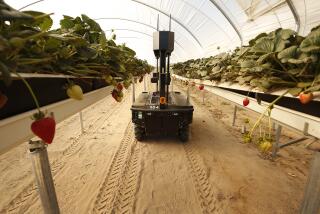Pierce Gets Giant Microscope : Agriculture Students Focus In
- Share via
It’s easy for college professor Phil DesMarteau to focus students’ attention during lab lectures.
He controls the focusing knob.
DesMarteau operates a 10-foot-long microscope that 14 students can peer through at one time during lectures about blood cells and muscle tissue in animal science classes at Pierce College.
Officials at the Woodland Hills campus bought the $35,000 device six weeks ago with a federal grant. The king-sized microscope’s manufacturer says it is the first of its kind in Southern California.
Covers 2 Tables
Put together like an oversized Tinker Toy set, the microscope is an eye-catcher that sprawls across two tables in DesMarteau’s agriculture department classroom.
A series of prisms and mirrors reflects brightly lighted, magnified cells to each view station. Abnormal cells and parasites, invisible to the naked eye, can be enlarged up to 1,000 times. They can also be pointed out with a tiny arrow.
“Now I can be sure that students are all looking at the right thing,” said DesMarteau, a veterinarian who has taught at Pierce College for 10 years.
“I don’t have to run from student to student to look through their microscopes and then tell them, ‘No, that’s not it.’ ”
As a result, DesMarteau and other instructors who use the big microscope can cover three times as much material as when students used smaller, individual microscopes, he said.
Efficiency is important for the agriculture program, which in the past has been threatened by encroaching development and declining enrollment.
Agriculture was the first department set up when Pierce was formed in 1947. These days, however, only 1,300 of Pierce’s 20,000 students take classes in the department. Most go straight to work after completing the two-year agriculture-science program, rather than to a four-year college.
Department officials say they must hustle to cover as much classroom material as possible during the two-year limit.
Paid for by Grant
Students who learn microscope skills and basic clinical pathology for animals are that much more employable, said Frank Baugh, assistant dean of academic affairs at the college. Such training qualified the school for the federal Vocational Education Assistance grant, which paid for the big microscope.
Students said they were glad to trade their individual microscopes for the mass-viewing system.
“There’s no danger that you’re just imagining that you’re seeing what the teacher is talking about,” said Lori Siverling, 30, of Van Nuys, who is studying to be an animal-health technician. Classmate Jackie De Jong, 20, of Sylmar, said students learn how microscopic analysis of blood, body fluids and tissue samples can detect everything from heart worms in dogs to kidney disease in cats.
UC Davis Has One
Although Pierce students and staff members had believed that they were the first in California to use a 14-station microscope, officials at the Buffalo, N.Y. company that manufactured it said one was already in use at the University of California, Davis.
Four or five of the microscopes are sold nationwide a year, said Tom Kammerer, sales administration manager for Reichert-Jung, the scientific instrument company that makes it.
“At that cost, you don’t sell them to institutions overnight,” said Jay Charles, the company’s western regional manager.
More to Read
Sign up for Essential California
The most important California stories and recommendations in your inbox every morning.
You may occasionally receive promotional content from the Los Angeles Times.










